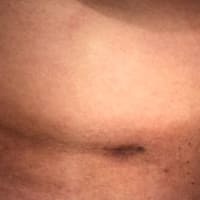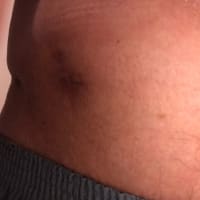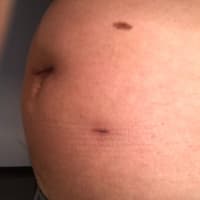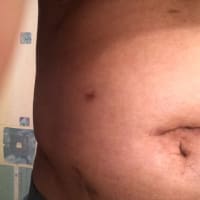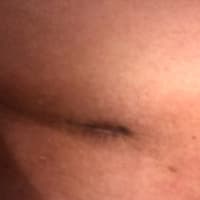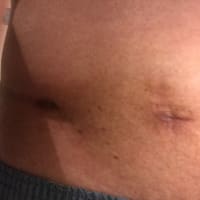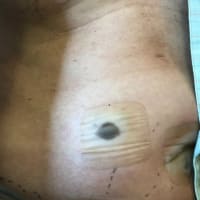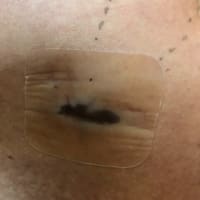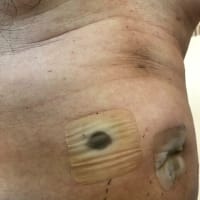NSFのQ&Aシリーズ最終回です。
http://www.scoliosis.org/resources/medicalupdates/adultscoliosis.php
Q:20歳を超えた大人が、突然、側弯症になる。ということはありえるのでしょうか?
A:それはあり得ますが、非常にまれなケースです。例えば、脊椎を骨折したという
ような事故などの場合がありえます。あるいは、筋ジストロフィーのような神経筋
肉性の病気を発症したとか、骨粗鬆症のようなメタボリックコンディションという
なケースもあります。もっとも多いケースが思春期に発症していた側弯症の場合で
す。つまり、特発性の範疇で、原因不明ということになります。
Q:大人の側弯というのは、年をへるごとに悪化するのでしょうか?
A:私たちは患者さんを20年間にわたり経過観察して、約60%では悪化することはなく
、残り40%のうちの10%の患者さんではかなり早く進行するタイプで、30%の患者さん
は緩やかな進行で、おそらく年1度以下と思われます。
Q:進行するリスクとか、減少するというようなことに関与する因子はあるのでしょうか?
A:あります。座りっぱなしの仕事をしている人とか、体重過多の人などはリスクが
高くなります。
Q:大人の側弯の場合は、どういう治療をするのでしょうか?
A:第一に理解していただきたいのは、側弯を有する多くの大人の場合は、治療を
必要とするような重篤なカーブではない、ということです。変形も大きくはなく
呼吸器系障害もないのが大半です。また痛みもありません。
しかし、例えば 50度を超えるようなカーブの場合は、手術を考慮することになります。
Q:手術が必要であると、どうやって判断するのでしょうか?
A:4つの要素から判断します。痛み、進行性かどうか、形態(外観の見た目)、呼吸器
です。そのなかでも「痛み」が大きな比重をしめ、それが側弯に起因しているか
どうか、という点です。進行性については、一年間に5度以下の場合は、まだ手術
かどうか決めかねます。5度という幅は、他の要因もありえるからです。例えば、
40代の女性を午前中にレントゲン撮影してカーブが50度を示したとします。でも
同じ女性を夕方にレントゲン撮影すると....その人が仕事で疲れているような場合
ですと、55度とか60度を示すことがあります。
Q:形態(外観の見た目)とか、呼吸器というのはどういうことでしょうか?
A:外観というのはレントゲンには記録できませんので、写真撮影をして、脊椎が
時間経過とともに回旋し悪化していないか、肋骨がさらに隆起していないか、
カーブ進行のために身長が縮んでいないか、ということを観察します。
呼吸器というのは、肺疾患を併発するリスクを有する患者さんというのは、通常は
胸椎部で75度以上のカーブを有する場合になります。胸腰椎部~腰椎部のカーブの
患者さんの場合は、たいていは呼吸器系には問題はありません。
Q:手術での合併症を増大させる要因にはどういうものがあるでしょうか?
A:もし手術がダブルカーブの場合は、患者さんは二度の手術を受けることになる
かもしれません。回数が増えるわけですから、リスクも当然増えることになります。
患者さんの総合的な健康状態が合併症を起こすかどうかには大きく影響してきます。
もちろん、術者の経験とスキルも関係してきます。
Q:手術の方法/タイプとか、年齢、健康状態などが手術後の回復状態に影響を与える
のは理解しているのですが、一般的には、どれくらいの期間で仕事に復帰できる
のでしょうか?
A:はい、患者さんのケースにより状況はかなり変化します。しかし、患者さんの
気力が充実していて、職場からそれほど離れていないような場合でしたら、6週間
ほどで復帰することができます。もちろん、それについては主治医とよく相談し
指示をあおいで下さい。
Q:手術後の回復について何かアドバイスをいただけますか?
A:適正な休養をとること、主治医から運動を推奨された場合、カルシュウム豊富な
食事をとり、ビタミンD含有の牛乳を飲んだり、ヨーグルト、チーズ、骨のある魚、
ブロッコリーのような野菜、海藻などを摂取して下さい。
また、酒やタバコ、コーヒーは避るようにして下さい。これらは骨形成率と質を
減少させるので。
Q:大人の側弯症手術患者に対して、その他の指導はありますでしょうか?
A:それぞれの主治医が患者さんごとに適した指導を与えてくれるでしょう。
病後の回復期には、激しい運動や重いものを持ち上げたり、とということは避けて
下さい。手術後6週間したら、性生活も大丈夫でしょうが、危険のない体位について
は主治医からの指導をあおいでください。
私の意見としては、側弯症手術を受けた女性は、手術後少なくとも2年間はこどもを
生まないほうがいいと思います。手術した範囲/大きさとも関係してきますので、
広範囲手術の場合は、さらにその期間については考慮が必要でしょう。
Q:最後の質問ですが、運動についてですが、側弯症患者さんにどういう運動が
よいですか?
A:運動は痛みの緩和には効果があると思います。私が推奨するのは水泳です。
クロールか背泳がいいと思います。
ただし、運動が側弯カーブを治したり、進行を止めるわけではないことは理解して
おいて下さい。
..........................................................................
(august03より)
上記Q&Aのなかで妊娠について記載がありますが、ここの部分は20代~40代の女性
を想定しての回答と考えるのがよいと思います。
ここで回答されている先生が「2年間」という期間をあげているのは、脊柱固定手術
により、骨癒合がしっかりと完成することを期待しての2年間という意見になって
いると思います。整形外科の先生に妊娠、出産の適否を聞いたり、産科の先生に
骨癒合状態の適否を聞いても、それぞれに専門外のことですから、回答に窮する
ことが想像されます。妊娠出産を考えている女性のかたは、手術後の定期検査で
骨癒合状態をしっかりと整形外科の先生に確認することを忘れないで下さい。
側弯症手術をしても、多くの女性が妊娠し出産されています。ここで提示されて
いる2年間というのは安全を考慮しますと、さらに妥当な期間ではないかと思います
(ブログ内のカテゴリー「側弯症と妊娠」や掲示板での経験者の発言を参照)
下記URLにも説明を記載していますので、参照ください
Little by little [大人の側弯症]
http://sokuwan.googlepages.com/adultscoliosis2
//////////////////////////////////////////////////////////////////////////
Q: Dr. Levine, is it possible for an adult, a person 21 years of age or
older, to suddenly "get" scoliosis?
A: It's possible but extremely rare. When it happens, it is usually
because the patient has experienced some sort of trauma, such as a
fractured spine, or because the person develops a neuromuscular condition
like muscular dystrophy, or a metabolic condition like osteoporosis that
softens the bones. Most often, however, adult scoliosis develops in
adolescence, and is the "idiopathic" variety, which means it occurs for no
apparent reason.
Q: Will untreated adult scoliosis get worse year after year?
A: I've followed patients for over twenty years, and have found that
probably 60% of adult patients do not get worse. Of the remaining 40%
about 10% show a very significant progression, while the other 30% will
show a very mild progression, maybe less than one degree per year.
Q: Are there any factors that can decrease or increase one's risk of
progression?
A: Yes, there are. The person who is sedentary and overweight is inviting
problems.
Q: What treatments are available for adults with scoliosis?
A: First, one has to understand that many adults who have scoliosis never
require treatment; they do not have obvious deformities or breathing
problems, and they have no pain. But when an adult has a curvature that is
approximately 50 degrees or more, then we begin to consider the
possibility of spinal fusion surgery.
Q: How do you decide on who's a proper candidate for spine surgery?
A: We look at four factors; pain, progression, appearance, and pulmonary.
Pain must be significant, and must be related to the scoliosis. Regarding
progression, anything under 5 degrees within a year is questionable. A 5
degree change can be the result of any number of variables. For example an
x-ray taken of a 40-year-old woman early in the morning might show a 50
degree curve, but an x-ray of the same woman taken at 5 p.m. when she's
tired and slumping could show a curve that's 5-10 degrees greater.
Q: And what about appearance and pulmonary?
A: While we cannot document appearance with x-rays, simple photographs can
be helpful in revealing whether one's vertebral rotation has gotten worse
over time, whether ribs are sticking out more, or whether one has lost
height due to an increased curvature.
Regarding pulmonary, patients who are at risk for restrictive lung disease
are usually those individuals who have a scoliotic curvature of more than
75 degrees in the thoracic (upper back) area. Patients who have lumbar
(lower back) or thoraco-lumbar (mid back) curves will usually have
pulmonary functions that are normal.
Q: What factors increase the complication of surgery?
A: If surgery involves correction of two curves instead of just one, the
patient may have to undergo two surgeries, which of course increases the
odds for complications. The patient's general health is a factor that can
affect complication rates, as is the experience and skill level of the
surgeon performing the operation.
Q: We know that healing time will vary depending upon the type of surgery
performed, and the age and health of the patient. But in general, when can
adult surgical patients expect to return to work?
A: You're right, it is quite variable. But a motivated person, living a
reasonable distance from an office location, could return to work in six
weeks. Of course, a patient should follow the advice of his or her
orthopedist.
Q: Any suggestions for helping patients heal properly?
A: In addition to proper rest, and whatever exercise is recommended by
their orthopedist, surgical patients should consume foods that are high in
calcium and vitamin D skim milk, for example as well as foods such as
yogurt, cheese, bony fish, vegetables such as broccoli, even Japanese
seaweed. Avoid excess alcohol, coffee, and tobacco; these will decrease
the rate and quality of bone formation
Q: Any other guidelines for adult surgical patients?
A: Each patient's surgeon will make his or her own recommendations, but
during convalescence, one should avoid strenuous physical activities and
heavy lifting. Six weeks after surgery, it's all right to have sex, but
actual details of positions should be discussed with one's surgeon. In my
opinion, women who've had scoliosis surgery should not consider delivering
a child until at least two years after the surgery; it takes that long for
fusion to become as hard as it should.
Q: One last question. Will you set the record straight for us about
exercise and what it can do for scoliosis?
A: Exercise can help pain that may be associated with scoliosis; the best
you can do is swimming the sidestroke and the backstroke. But exercise is
not a treatment for scoliosis it cannot stop a cuve from progressing.
http://www.scoliosis.org/resources/medicalupdates/adultscoliosis.php
Q:20歳を超えた大人が、突然、側弯症になる。ということはありえるのでしょうか?
A:それはあり得ますが、非常にまれなケースです。例えば、脊椎を骨折したという
ような事故などの場合がありえます。あるいは、筋ジストロフィーのような神経筋
肉性の病気を発症したとか、骨粗鬆症のようなメタボリックコンディションという
なケースもあります。もっとも多いケースが思春期に発症していた側弯症の場合で
す。つまり、特発性の範疇で、原因不明ということになります。
Q:大人の側弯というのは、年をへるごとに悪化するのでしょうか?
A:私たちは患者さんを20年間にわたり経過観察して、約60%では悪化することはなく
、残り40%のうちの10%の患者さんではかなり早く進行するタイプで、30%の患者さん
は緩やかな進行で、おそらく年1度以下と思われます。
Q:進行するリスクとか、減少するというようなことに関与する因子はあるのでしょうか?
A:あります。座りっぱなしの仕事をしている人とか、体重過多の人などはリスクが
高くなります。
Q:大人の側弯の場合は、どういう治療をするのでしょうか?
A:第一に理解していただきたいのは、側弯を有する多くの大人の場合は、治療を
必要とするような重篤なカーブではない、ということです。変形も大きくはなく
呼吸器系障害もないのが大半です。また痛みもありません。
しかし、例えば 50度を超えるようなカーブの場合は、手術を考慮することになります。
Q:手術が必要であると、どうやって判断するのでしょうか?
A:4つの要素から判断します。痛み、進行性かどうか、形態(外観の見た目)、呼吸器
です。そのなかでも「痛み」が大きな比重をしめ、それが側弯に起因しているか
どうか、という点です。進行性については、一年間に5度以下の場合は、まだ手術
かどうか決めかねます。5度という幅は、他の要因もありえるからです。例えば、
40代の女性を午前中にレントゲン撮影してカーブが50度を示したとします。でも
同じ女性を夕方にレントゲン撮影すると....その人が仕事で疲れているような場合
ですと、55度とか60度を示すことがあります。
Q:形態(外観の見た目)とか、呼吸器というのはどういうことでしょうか?
A:外観というのはレントゲンには記録できませんので、写真撮影をして、脊椎が
時間経過とともに回旋し悪化していないか、肋骨がさらに隆起していないか、
カーブ進行のために身長が縮んでいないか、ということを観察します。
呼吸器というのは、肺疾患を併発するリスクを有する患者さんというのは、通常は
胸椎部で75度以上のカーブを有する場合になります。胸腰椎部~腰椎部のカーブの
患者さんの場合は、たいていは呼吸器系には問題はありません。
Q:手術での合併症を増大させる要因にはどういうものがあるでしょうか?
A:もし手術がダブルカーブの場合は、患者さんは二度の手術を受けることになる
かもしれません。回数が増えるわけですから、リスクも当然増えることになります。
患者さんの総合的な健康状態が合併症を起こすかどうかには大きく影響してきます。
もちろん、術者の経験とスキルも関係してきます。
Q:手術の方法/タイプとか、年齢、健康状態などが手術後の回復状態に影響を与える
のは理解しているのですが、一般的には、どれくらいの期間で仕事に復帰できる
のでしょうか?
A:はい、患者さんのケースにより状況はかなり変化します。しかし、患者さんの
気力が充実していて、職場からそれほど離れていないような場合でしたら、6週間
ほどで復帰することができます。もちろん、それについては主治医とよく相談し
指示をあおいで下さい。
Q:手術後の回復について何かアドバイスをいただけますか?
A:適正な休養をとること、主治医から運動を推奨された場合、カルシュウム豊富な
食事をとり、ビタミンD含有の牛乳を飲んだり、ヨーグルト、チーズ、骨のある魚、
ブロッコリーのような野菜、海藻などを摂取して下さい。
また、酒やタバコ、コーヒーは避るようにして下さい。これらは骨形成率と質を
減少させるので。
Q:大人の側弯症手術患者に対して、その他の指導はありますでしょうか?
A:それぞれの主治医が患者さんごとに適した指導を与えてくれるでしょう。
病後の回復期には、激しい運動や重いものを持ち上げたり、とということは避けて
下さい。手術後6週間したら、性生活も大丈夫でしょうが、危険のない体位について
は主治医からの指導をあおいでください。
私の意見としては、側弯症手術を受けた女性は、手術後少なくとも2年間はこどもを
生まないほうがいいと思います。手術した範囲/大きさとも関係してきますので、
広範囲手術の場合は、さらにその期間については考慮が必要でしょう。
Q:最後の質問ですが、運動についてですが、側弯症患者さんにどういう運動が
よいですか?
A:運動は痛みの緩和には効果があると思います。私が推奨するのは水泳です。
クロールか背泳がいいと思います。
ただし、運動が側弯カーブを治したり、進行を止めるわけではないことは理解して
おいて下さい。
..........................................................................
(august03より)
上記Q&Aのなかで妊娠について記載がありますが、ここの部分は20代~40代の女性
を想定しての回答と考えるのがよいと思います。
ここで回答されている先生が「2年間」という期間をあげているのは、脊柱固定手術
により、骨癒合がしっかりと完成することを期待しての2年間という意見になって
いると思います。整形外科の先生に妊娠、出産の適否を聞いたり、産科の先生に
骨癒合状態の適否を聞いても、それぞれに専門外のことですから、回答に窮する
ことが想像されます。妊娠出産を考えている女性のかたは、手術後の定期検査で
骨癒合状態をしっかりと整形外科の先生に確認することを忘れないで下さい。
側弯症手術をしても、多くの女性が妊娠し出産されています。ここで提示されて
いる2年間というのは安全を考慮しますと、さらに妥当な期間ではないかと思います
(ブログ内のカテゴリー「側弯症と妊娠」や掲示板での経験者の発言を参照)
下記URLにも説明を記載していますので、参照ください
Little by little [大人の側弯症]
http://sokuwan.googlepages.com/adultscoliosis2
//////////////////////////////////////////////////////////////////////////
Q: Dr. Levine, is it possible for an adult, a person 21 years of age or
older, to suddenly "get" scoliosis?
A: It's possible but extremely rare. When it happens, it is usually
because the patient has experienced some sort of trauma, such as a
fractured spine, or because the person develops a neuromuscular condition
like muscular dystrophy, or a metabolic condition like osteoporosis that
softens the bones. Most often, however, adult scoliosis develops in
adolescence, and is the "idiopathic" variety, which means it occurs for no
apparent reason.
Q: Will untreated adult scoliosis get worse year after year?
A: I've followed patients for over twenty years, and have found that
probably 60% of adult patients do not get worse. Of the remaining 40%
about 10% show a very significant progression, while the other 30% will
show a very mild progression, maybe less than one degree per year.
Q: Are there any factors that can decrease or increase one's risk of
progression?
A: Yes, there are. The person who is sedentary and overweight is inviting
problems.
Q: What treatments are available for adults with scoliosis?
A: First, one has to understand that many adults who have scoliosis never
require treatment; they do not have obvious deformities or breathing
problems, and they have no pain. But when an adult has a curvature that is
approximately 50 degrees or more, then we begin to consider the
possibility of spinal fusion surgery.
Q: How do you decide on who's a proper candidate for spine surgery?
A: We look at four factors; pain, progression, appearance, and pulmonary.
Pain must be significant, and must be related to the scoliosis. Regarding
progression, anything under 5 degrees within a year is questionable. A 5
degree change can be the result of any number of variables. For example an
x-ray taken of a 40-year-old woman early in the morning might show a 50
degree curve, but an x-ray of the same woman taken at 5 p.m. when she's
tired and slumping could show a curve that's 5-10 degrees greater.
Q: And what about appearance and pulmonary?
A: While we cannot document appearance with x-rays, simple photographs can
be helpful in revealing whether one's vertebral rotation has gotten worse
over time, whether ribs are sticking out more, or whether one has lost
height due to an increased curvature.
Regarding pulmonary, patients who are at risk for restrictive lung disease
are usually those individuals who have a scoliotic curvature of more than
75 degrees in the thoracic (upper back) area. Patients who have lumbar
(lower back) or thoraco-lumbar (mid back) curves will usually have
pulmonary functions that are normal.
Q: What factors increase the complication of surgery?
A: If surgery involves correction of two curves instead of just one, the
patient may have to undergo two surgeries, which of course increases the
odds for complications. The patient's general health is a factor that can
affect complication rates, as is the experience and skill level of the
surgeon performing the operation.
Q: We know that healing time will vary depending upon the type of surgery
performed, and the age and health of the patient. But in general, when can
adult surgical patients expect to return to work?
A: You're right, it is quite variable. But a motivated person, living a
reasonable distance from an office location, could return to work in six
weeks. Of course, a patient should follow the advice of his or her
orthopedist.
Q: Any suggestions for helping patients heal properly?
A: In addition to proper rest, and whatever exercise is recommended by
their orthopedist, surgical patients should consume foods that are high in
calcium and vitamin D skim milk, for example as well as foods such as
yogurt, cheese, bony fish, vegetables such as broccoli, even Japanese
seaweed. Avoid excess alcohol, coffee, and tobacco; these will decrease
the rate and quality of bone formation
Q: Any other guidelines for adult surgical patients?
A: Each patient's surgeon will make his or her own recommendations, but
during convalescence, one should avoid strenuous physical activities and
heavy lifting. Six weeks after surgery, it's all right to have sex, but
actual details of positions should be discussed with one's surgeon. In my
opinion, women who've had scoliosis surgery should not consider delivering
a child until at least two years after the surgery; it takes that long for
fusion to become as hard as it should.
Q: One last question. Will you set the record straight for us about
exercise and what it can do for scoliosis?
A: Exercise can help pain that may be associated with scoliosis; the best
you can do is swimming the sidestroke and the backstroke. But exercise is
not a treatment for scoliosis it cannot stop a cuve from progressing.












